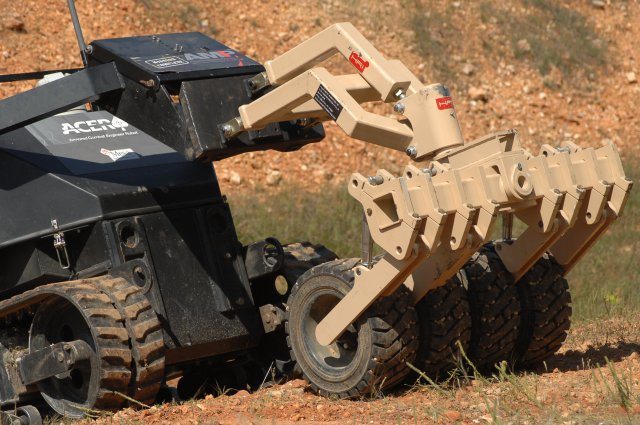Robots on the modern battlefield can do a multitude of tasks that help keep Soldiers safe and help them be more productive — and in some cases, those robots can do too many tasks.
For two weeks in September, the Capabilities Development and Integration Directorate hosted a series of hands-on events as part of a Dismounted Engineer Mobility System Military Utility Assessment to help determine what functions were needed on particular robots and what was missing.
The concept of the assessment is to bring engineers who design and build the robots to Fort Leonard Wood and allow combat engineer Soldiers to see and use the emerging technologies. Information is passed both ways as Soldiers tell the developers what features can make their jobs easier and safer in a combat environment, and the developers can showcase some of their newer developments and get feedback from the Soldiers on how it might be deployed and how to improve it, said Paul Rusinko, CDID Experimentation Branch chief.
“Think of this like a Swiss Army knife,” said Lt. Col. Bryan Salyers, Assured Mobility acquisition officer. “You have 30 blades and tools, but you really only use six, but you could still use a small screwdriver. We’re here to find out which six you need, and how to add a screwdriver.”
The assessment allows Soldiers to tell the contractors what they use in the field so that the right mix of capabilities can be integrated in the future into one platform — or one robot, Salyers said.
Assisting were Soldiers from the 509th Route Clearance Company, 5th Engineer Battalion, from Fort Leonard Wood and the 428th Engineer Company, U.S. Army Reserves, from Wausau, Wis. Both companies had recently returned from deployments in Afghanistan and both had experience in dismounted operations.
“This is one of the best ideas I have seen the Army do,” said Sgt. Jerome Bailey, 428th Eng. Co., referring to the assessment. “Normally, it’s ‘here’s a new piece of equipment, figure out how to use it.’ But here, we are giving our input into how the next generation of these robots can be used downrange. These contractors are actually asking us ‘What can we do to improve this?'”
For other Soldiers, the assessment gave them an opportunity to view new emerging technologies and begin to imagine how they could use the latest developments in a tactical situation.
“I’m impressed with the early stages of some of these robots,” said Spc. James Woodside, 509th Route Clearance Company. “I can see how this could have been a real asset when we were deployed,” he said referring to a robotic mine detector.
Twelve different equipment providers were represented during the assessment offering a wide variety of equipment, robotics and functions, Rusinko said.
“We couldn’t have done this without the cooperation of the companies involved. We have QinetiQ, Mesa Technologies, XADS, HDT Robotics, Lockheed Martin, Mobile Hydraulic, Polaris Defense, Bobcat and Gyrocam, plus Army Research and Development Labs, Night Vision Electronic Sensors Directorate and Tank and Automotive Research, Development, and Engineering Center and Program Managers for the Robotic Systems Joint Project Office — all out here on their own dime,” Rusinko said.
One product that proved popular with the Soldiers was a robotic functioning arm and hand created by HDT Robotics.
Maj. Gene Porter, Requirements Determination Division, Protection Branch, Capability Development and Integration Directorate, thought the controls of the ADROIT system took some getting used to.
“It was a little awkward, but I can see how, with practice, it would be easy to use,” Porter said. “It looks like it’s going to feel natural (using the controls), but it’s not once you start using it. It’s not very ergonomic.”
Spc. Jason Arnoldussen, 428th Engineer Company, took to the controls right away.
“That’s sweet,” Arnoldussen said after maneuvering the robot hand to pick up a plastic water bottle with ease.
Arnoldussen later explained that he had trained on and used a similar, but smaller PacBot robot while deployed in Afghanistan last year. The ADROIT impressed him.
“I loved it. This was the first time I ever tried it, and I got a pretty easy handle on it,” he said. “I could see a huge improvement in the way you can manipulate things with the clamp and the way the hand was maneuverable. It was pretty unreal how you could get to stuff.”
The assessment ended Friday with an After Actions Review and a demonstration of robotic capabilities in a variety of functions.










